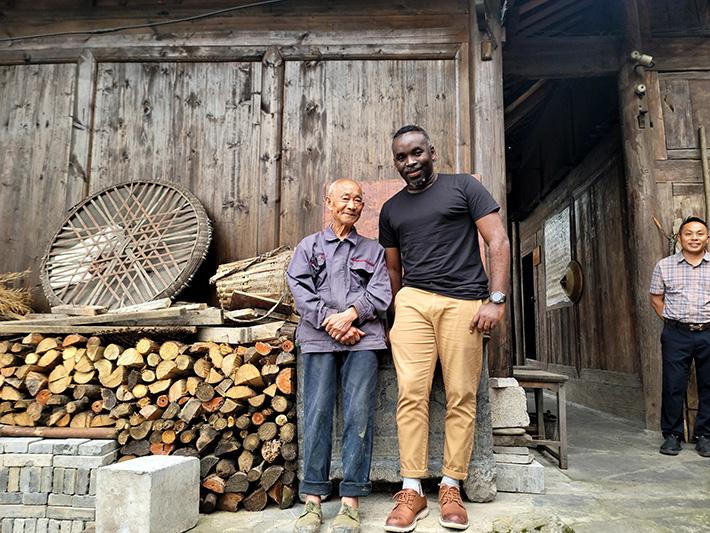
Donatien Niyonzima poses for a photo with one of the 253 people living in 53 households in Tianchi Miao Village, Houping Township, Chongqing, on 8 June
In the vast and diverse landscapes of rural areas of Chongqing in southwest China, a remarkable transformation is unfolding. The combination of effective poverty alleviation strategies and comprehensive rural revitalisation efforts has turned these once impoverished regions into thriving centres of growth and development. As an African visitor to Chongqing, I was captivated by the unique approach taken to combat poverty and revitalise rural communities. During my recent visit to the municipality, I had the privilege of witnessing first-hand the remarkable progress being made in these areas.
Here, I would talk about what makes Chongqing’s model worth emulating by other developing countries, particularly African countries seeking to address poverty and revitalise their rural areas.
To fully appreciate the impact of poverty alleviation and rural revitalisation efforts in Chongqing, it is important to understand the unique context of this region. Chongqing is a megacity encompassing both urban and rural areas. Historically, rural poverty has been a significant challenge, with geographic barriers, limited access to resources, and underdeveloped infrastructure contributing to the plight of rural communities. However, the government’s commitment to address these issues through targeted policies and sustained efforts has led to remarkable progress.
Integrated approaches
To consolidate the achievements and build a “defence line against the return of poverty,” Chongqing has comprehensively promoted the continuation of development efforts in four aspects, effectively linking the consolidation and expansion of poverty-alleviation achievements with rural revitalisation. It’s therefore correct to say that Chongqing’s success can be attributed to the four interconnected aspects that form the core of its strategy which are continued responsibilities, continued policy, continued assistance, and continued supervision.
The municipality’s poverty alleviation and rural revitalisation efforts are built on a foundation of continued responsibilities. The government has remained steadfast in its commitment to improving the lives of rural residents, ensuring that poverty reduction remains a top priority. Policies and programmes are consistently implemented and adjusted based on the evolving needs of the communities. This continuity ensures that progress is not short-lived but sustained over time.
The above is supported by a key element which lies in the continuation of supportive policies. The government has implemented a range of policies that provide guidance and resources to uplift rural areas. These policies create an enabling environment for development, promoting investment, innovation, and entrepreneurship in the rural sectors. The long-term nature of these policies allows for stability and predictability, encouraging sustained growth and progress.
Its poverty alleviation and rural revitalisation efforts are complemented by continued assistance. The government provides targeted support to vulnerable populations, ensuring that no one is left behind. Assistance programmes focus on providing training, financial aid, and social welfare benefits to those in need. By continuously assisting the most disadvantaged members of society, Chongqing strives to create an inclusive and equitable rural development landscape.
To fully achieve the intended targets, Chongqing’s efforts are also accompanied by continued supervision. The government maintains oversight and accountability to ensure that the implemented policies and programmes are effective. Regular monitoring, evaluation, and feedback mechanisms allow for course corrections and improvements. This commitment to supervision ensures that resources are utilised optimally and that the intended outcomes of poverty reduction and rural development are achieved.

View of one of the sightseeing villages in Qianjiang District, Chongqing, on 8 June
Investing in key sectors
One of the key aspects of Chongqing’s rural revitalisation is the significant investment in infrastructure development. Improved road networks, transportation systems, and access to electricity have not only connected rural areas with urban centres, but have also unlocked economic opportunities.
The 2023 Implementation Plan for Promoting Effective Investment in Infrastructure issued by the Chongqing Municipal Commission of Housing and Urban-Rural Development proposes that Chongqing’s planned investment in infrastructure in 2023 will be 135 billion yuan ($18.9 billion), an increase of 12.5 percent compared with 2022. These infrastructure improvements have brought about a positive ripple effect, stimulating economic growth and creating jobs in the rural areas.
Leveraging on infrastructure and recognising the importance of agriculture in rural development, Chongqing has also implemented agricultural reforms and fostered innovation in this sector. The promotion of modern farming techniques, the introduction of advanced machinery and equipment, and the adoption of sustainable farming practices have increased agricultural productivity and improved the quality of rural livelihoods.
During my tour, I also learned that education and healthcare are vital components of human development and poverty alleviation. Chongqing has made significant efforts to improve access to quality education and healthcare services in rural areas. The establishment of schools, vocational training centres, and medical facilities has bridged the gap between rural and urban areas, ensuring that rural residents have access to essential services. I was impressed by the training schools that train young people from poor families the skill of forklifting. The schools have already trained more than 1,268 young girls and boys from rural Chongqing.
Chongqing’s rural revitalisation efforts place great emphasis on fostering entrepreneurship and supporting rural industries. By providing financial support, business training, and mentorship programmes, the government has encouraged the establishment of small and medium-sized enterprises in rural areas. These initiatives have led to the emergence of thriving rural industries, such as tourism, handicrafts, agribusiness, and e-commerce.
An excellent model for Africa
The experiences and successes of Chongqing in poverty alleviation and rural revitalisation offer valuable lessons for African countries striving to overcome similar challenges. It’s worth mentioning that a comprehensive and integrated approach is crucial, addressing not only economic poverty but also the underlying factors that perpetuate poverty. This includes investing in infrastructure, improving access to education and healthcare, promoting agricultural reforms, fostering rural industries, and harnessing technology.
Strong leadership and political commitment are essential to poverty alleviation and rural revitalisation. Chongqing’s progress can be attributed to the unwavering dedication of government officials and leaders in prioritising poverty alleviation and rural development. African countries should ensure that poverty reduction and rural revitalisation remain the top priority, backed by long-term policies and sustained efforts.
Furthermore, partnerships and collaborations are key. Chongqing’s successes have been facilitated by cooperation among the government, private sector, and other organisations. African nations can benefit from forging partnerships with countries like China, leveraging their expertise, resources, and experiences in poverty alleviation and rural development.